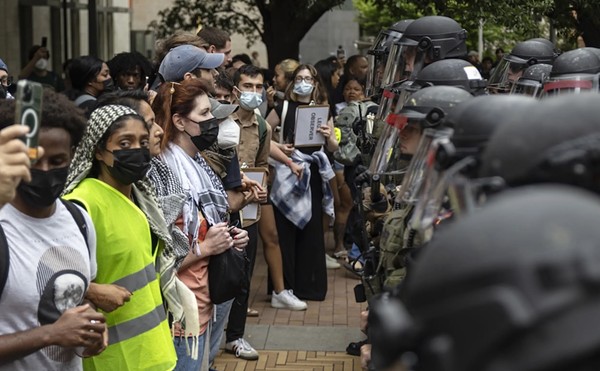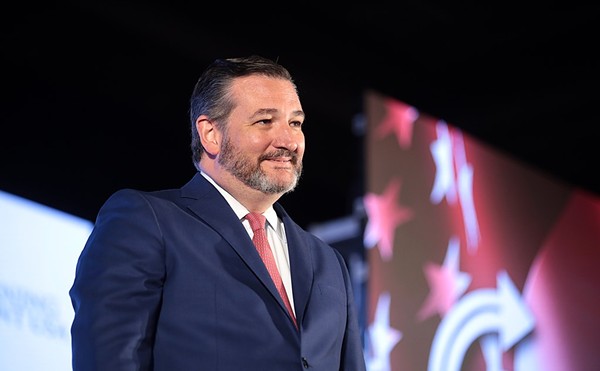Heading into the May 3, 2003 municipal election, City Hall reeks of scandal. District 5 Councilman David Garcia resigned over charges that he misappropriated campaign finance funds; District 2's John Sanders and District 4's Enrique "Kike" Martin face bribery charges stemming from law enforcement sting operations aimed at curbing corruption in Alamotown.
By appointing former Mayor Lila Cockrell to head his commission on trust and integrity, Mayor Ed Garza has made overtures to prompt City Council to clean up its act. Yet in its analysis, the panel acknowledged that previous "findings and recommendations of citizen commissions have been ignored or forgotten, adding to a sense of futility on the part of the public." So far, Council has shown no signs of changing the status quo at City Hall.
It is time to ask the questions: How did San Antonio politics fall into such a sorry state? And should local citizens trust any remedies proposed by City leaders?
Part of the answer can be found in the rise of the pro-business Good Government League in the 1950s, its decline in the early 1970s, and its current revival in the form of the Greater San Antonio Chamber of Commerce.
Henry Cisneros rose like a Phoenix from the GGL's ashes and evolved into a pro-business Supermayor in the 1980s, setting the tone for today's City Hall. In the '90s, self-appointed tax watchdog and Cisneros critic, C.A. Stubbs and his conservative Homeowner Taxpayers' Association, convinced the community that term limits would solve problems at City Hall - and subsequently, term limits were imposed and remain in effect today.
Add to the political complexity the increasing demand from Chicanos and African Americans to participate in the political process; yet, some elected officials such as David Garcia have failed to represent their constituents, further disenfranchising them.
History has repeated itself: The Greater Chamber and others who seek financial gain stand at the helm of city government and perpetuate the illusion that ordinary citizens, including Chicanos and African-Americans, have a modicum of power.
A BRIEF, SORDID HISTORY OF SA POLITICS
The agenda at weekly City Council meetings reflects and responds to the interests of big business. This is how the ruling class has conducted itself for decades - even a millennium. Begin with the conquistadores who invaded México and the New World with the publicly stated intent of spreading the word of God to the pagans. In reality, their purpose was to murder and enslave the indigents, mine the riches, and ship the spoils home to the king of Spain. The defenders of the Alamo cried "liberty and justice for all," but their underlying agenda was economic: to take the land and its wealth for themselves and their kin who poured into Texas, seeking their fortunes.
In the 20th century, "San Antonio's urban political history followed a pattern similar to other Sunbelt cities," wrote Kemper Diehl and Jan Jarboe in Cisneros: Portrait of a New American, published in 1984. "The 1940s saw the rise and fall of flamboyant municipal reformers; the 1950s and early 1960s were decades of sleepy efficiency when city government was in the hands of a few businessmen; and the late 1960s and early 1970s saw previously dormant interest groups demand power."
Fast forward to 1951, when the City Charter was changed in response to, (you guessed it) political corruption at City Hall and the rise of the Good Government League was imminent. The charter change demoted the mayor to a ceremonial leader, with an equal vote among other council members, and placed the real power in the hands of a city manager, the system that is in operation today. Simply put, the city
| The charter change demoted the mayor to a ceremonial leader, with an equal vote among other council members, and placed the real power in the hands of a city manager, the system that is in operation today. |
Tucker Gibson, professor and chairman of the political science department of Trinity University, explained that the strength of business' influence over City Hall was due to the Good Government League's grip on the amateur political scene from about 1955 to 1975. That influence - even without the Good Government League - lingers today. "They `the GGL` were not Democratic or Republican, but they called themselves an association," he explained. "They recruited candidates for City Council, but did it secretly. They raised funds, ran slates of candidates and they dominated city politics for a 20-year period."
According to Rodolfo Rosales' book, The Illusion of Inclusion: The Untold Political Story of San Antonio, "The new political arrangements brought about by the business community in 1951 were certainly not intended to create independent representation for the Chicano community, and they did not. However, a consequence of this more open political environment was that it set in motion a more competitive political environment that eventually brought about in the 1970s independent political representation for the Chicano community, a situation without precedent in San Antonio in this century."
Rosales, a political science professor at the University of Texas at San Antonio, credits the Chicano movement for changing the city's political face. "Mexican-Americans don't get credit for shit, except making tamales," Rosales said recently. "I started out with giving credit to Mexican-Americans who changed politics in San Antonio. We changed the town."
Rosales pointed out that the Good Government League was focused on the goals of the Greater San Antonio Chamber of Commerce: growth, expansion, and economic development. Yet, Chicanos, many of whom opposed the Good Government League, fought for representation through organizations such as the Bexar County Democratic Coalition, which included liberal North Side Anglos and East Side African-American leaders. As minorities were elected to office, they made inroads at county and state levels, but the city's political climate remained static until 1973, when independent candidate Charlie Becker ousted Good Government League-backed candidate Roy Barrera in an at-large election for City Council.
Meanwhile, in 1974, Henry G. Cisneros gave up an offer to teach at MIT, packed up his family and returned home to take a teaching slot at UTSA. "When Henry Cisneros returned to San Antonio, the city was in chaos," Diehl and Jarboe wrote in their profile of his political career. "The GGL, the conservative political organization which had run the city for 20 years was in shambles. The Anglo business establishment was divided into two warring factions. City government was paralyzed. Ethnic tensions ran high as Mexican-Americans made a long overdue, but painful drive for power."
Cisneros broke with the liberal Chicano ranks and ran on the West Side Good Government League ticket, winning the Place 3 spot on City Council in 1975. "This is not a time for complacency," read one of his campaign ads in a local newspaper. "It is time to thrust for our full potential as individuals and as a people. This being done, there shall be no excuses for the generations that follow." Cisneros linked economic development, not social welfare programs, to lifting San Antonio out of the wage doldrums - at a time when the average annual per capita income was $5,672.
Cisneros cast a crucial City Council vote concerning the U.S. Department of Justice's edict that the city change its charter to allow single-member voting districts to ensure that minorities were represented. The Justice Department put the hammer down after the city annexed huge properties on the North Side, adding many Anglo voters to the mix.
As a result of Cisneros' vote, the City conducted a referendum on the single-member districts rather than fight the order in court; with more than 52 percent of the vote, the proposal won to change the city charter. As a result, in 1977, five Chicanos and one African-American won council seats, giving minorities the majority at City Hall.
Cisneros served as a bridge between Anglos and Hispanics, and was a political shining star in the eyes of the nation; Walter Mondale considered him as a running mate during the 1984 presidential election. Cisneros had the backing of influential men such as B.J. "Red" McCombs, Jim Dement, Jim Uptmore, Ray Ellison and the newly organized North Side Chamber of Commerce, which took offense at the Good Government League's financial pact with the Greater San Antonio Chamber of Commerce to promote economic development in San Antonio. When Cisneros ran for mayor in 1981 against Good Government Leaguer John Steen, one investor quipped, "What this election is really about is the Oak Hills Country Club (in the Medical Center) versus the San Antonio Country Club, and us Oak Hills boys are going to beat the hell out of the old guys."
In 1988, Cisneros' reputation was slightly tarnished after the Current published an interview in which he admitted having an Anglo girlfriend, whom he refused to name. A few days later, a daily newspaper columnist revealed the shocking news that the media had known about the affair for more than a year, but had remained mum at the behest of wealthy powermongers: Henry had a girlfriend and her name was Linda Medlar. He stepped down as mayor in 1989, citing other reasons.
Personal relationships aside, Cisneros served three terms as city councilman and three terms as mayor, and gave the public the much-ridiculed Alamodome - what the Current dubbed the "Dillodome," then the "Tacodome," and what other pundits called the "Bubbadome." C.A. Stubbs referred to the domed stadium as Henry's Folly. What really rankled opponents of the dome is that Cisneros billed it as a venue suitable to host a National Football League team when he pitched the project to the public. Then he later retracted, stating he never really said the Alamodome was specifically for an NFL team. The stadium stands as a monument of the legacy of Cisneros, Supermayor with highly developed persuasive powers.
Cisneros had political opponents, and his greatest detractor was self-appointed tax watchdog C.A. Stubbs. A retired computer systems employee of Civil Service and founder of the Homeowner Taxypayer Association, Stubbs is partly responsible for the term limits enacted today.
Stubbs, who turned 80 in January, and who bills himself as "the No. 1 tax watchdog in Texas," turned over leadership of the Homeowner Taxpayer Association in 1990 to run a statewide, fiscally conservative group. "I was a staunch opponent of Henry Cisneros. I still am," he said recently. "I helped to set up term limits (at City Hall) because of Henry."
Term limits are the legacy of the HTA, and the center of a 1991 referendum battle. Since that public vote, a council member can serve only two, 2-year terms and is banned from serving in that office again; the same restrictions apply to the mayor. The effects of term limits have contributed to the Council's current woes, explained Tucker Gibson of Trinity University. "From my perspective, you get a number
| "What the election is really about is the Oak Hills Country Club (in the Medical Center) versus the San Antonio Country Club, and us Oak Hills boys are going to beat the hell out of the old guys." |
Gibson added that people who now get elected to a council seat have an agenda to pursue, but by the time two terms have lapsed, it is hard to pursue it. "By the time you are on your agenda, you're finished unless you run for mayor."
Rodolfo Rosales' contended - accurately - that the inclusion of minorities in city government is merely an illusion. Big business still has its way at City Hall, and with term limits in place, it's nigh impossible to fight the system. A lack of partisan politics - Democrats versus Republicans - results in an absence of political party slates. Following the charter change in 1977, Rosales said, "The city council came up with a 10-1 plan, the mayor-council government. But, they missed the boat. The GGL was a party, but the non-partisan rule excluded political parties. That is the crux of the issue. You don't have an agenda by which to keep candidates accountable."
Ordinary citizens who are gnashing their molars and plugging in the plancha to iron out the kinks in their voter registration cards might believe that by electing new faces to City Hall, things will change - but the prospect is dim. Historically, big business interests dominate the language of the agenda, and Council members and the mayor have individual goals to work into the city government. The system works in perpetuity, as new faces are elected and placed on the Council dais, and new rounds of negotiations begin. First, big business gets a huge slice of the pie, with the leftovers to be fought over by the citizens who have to pay the baker.
San Antonio is not going to fall into a giant sinkhole if we experiment with the City Charter in an effort to put ordinary citizens on equal terms with power-hungry business interests.
The ethics panel has recommended term limits and lifetime bans for those who have served be terminated and that the mayor and council members get paid living-wage salaries. The City has survived numerous forms of government, and its citizens have proven resilient enough to accept - or resist - a changing of the guard. •


















